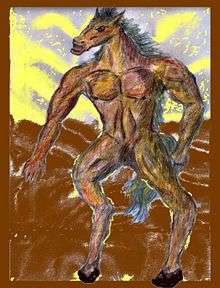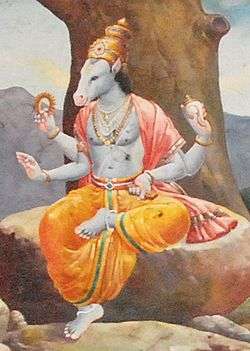Tikbalang
| Tikbalang | |
|---|---|
 | |
| Gender | Unknown, most likely male |
| Region | Philippines |
The Tikbalang (/ˈtikbaˌlaŋ/) (also Tigbalang, Tigbalan, Tikbalan, Tigbolan, or Werehorse) is a creature of Philippine folklore said to lurk in the mountains and forests of the Philippines. It is a tall, bony humanoid creature with the head and hooves of a horse and disproportionately long limbs, to the point that its knees reach above its head when it squats down.[1] In some versions it is a transformation of an aborted fetus sent to earth from limbo.[2]
Origins
The form of the Tikbalang traces back 4000 years, with roots in Hinduism which explain how that influence evolved into the mysterious half-horse creature we know today.[3][4]
Ancient people's in the Philippines believed in animism. They believed that the world has its own consciousness and that stones, trees, mountains, water, animals, sun, moon had a hidden power known as the spirit or the 'idol'. This power could be good or harm the spirit, but it was believed to control some aspects of life. in 1589, during the earliest days of the Spanish occupation, Father Juan de Plasencia documented the long-term Tikbalang awareness of indigenous peoples.[5]
Hinduism, from its origins in India, spread to Southeast Asia in 200 CE as Indian cultural influence spread throughout the region through trade routes. Tikbalang may have originated from Hayagriva, an avatar of the Hindu god Vishnu. The worship of Hayagriva was recorded in 2000 BCE.[6]
The images for giant flying birds, the Tikbalang, and Sirena are straight out of Hindu imagery. Influence on religion was also prevalent with the concept of a multi-layered world – Heaven and Hell. According to the Hindu Puranas, there are fourteen worlds in the universe: the seven upper and the seven lower. The seven upper worlds are Bhuh, Bhavah, Swah, Mahah, Janah. Tapah, and Satyam; and the seven nether worlds are Atala, Vitala, Sutala, Rasatala, Talatala, Mahatala, and Patala. The region known as Bhuh is the earth where we dwell.[7]
Began its association with Tikbalang 1860 discovery of a statue to Cambodia since the 10th century. It described the demons that Vadavamuka, the more radical version of the avatar of Vishnu. Eventually, Buddhism changed the image of Hayagriva a small horse's head floated to crown fire. In China, provided the old image of Hayagriva face with horses - one of the demons keeper into the inferno. Probably has the same happened in Tikbalang adapt it to the Filipinos in their beliefs after exacting culture through trade. Nine hundred years before the Spaniards arrived, went to the Chinese merchants in the Philippines and while there they use horses. But there's just started the evolution of Tikbalang.[8]
Superstitions
Tikbalangs or Tigbolan scare travelers, lead them astray and play tricks on them such that the travelers keep on returning to an arbitrary path no matter how far they go or turn. This is counteracted by wearing one's shirt inside out. Another countermeasure is to ask permission out loud to pass by or, not to produce too much noise while in the woods in order not to offend or disturb the tikbalang. The "tigbolan" is a ghost which assumes a variety of forms, and sometimes confers a similar gift upon certain favored individuals, in much the same way as the devil was wont to grant extraordinary powers to a few of our adventuresome forefathers. A superstition popular with the Tagalogs of Rizal Province is that Tikbalangs are benevolent guardians of elemental kingdoms. They are usually found standing at the foot of large trees looking around for anyone who dare to bestow malignancy on their kingdom's territory.
A common saying has it that rain from a clear sky means "may kinakasal na tikbalang."(Filipino, "a tikbalang is getting married".) This was potentially connected with a similar Spanish proverb that claimed a witch was getting married when there was rain on a sunny day, although many cultures have such sayings in which a trickster figure gets married (cp. fox's wedding, bear's wedding, monkey's birthday/wedding).
In some versions, the tikbalang can also transform itself into human form or turn invisible to humans. They like to lead travelers astray.[1]
Tikbalang are generally associated with dark, sparsely populated, foliage-overgrown areas, with legends variously identifying their abode as being beneath bridges, in bamboo clumps or banana groves, and atop Kalumpang (Sterculia foetida)[9] or Balite (Ficus indica) trees.
Taming a tikbalang
By one account a tikbalang has a mane of sharp spines, with the three thickest of these being of particular importance. A person who obtains one of these spines can use them as an anting-anting (talisman) in order to keep the tikbalang as his servant. The tikbalang must first be subdued, however, by leaping onto it and tying it with a specially-prepared cord. The would-be-tamer must then hang on while the creature flies through the air, fighting madly to dislodge its unwelcome rider, until it is exhausted and acknowledges its defeat.[2] Or you can look on his mane and you will see 3 golden hairs and if you pluck 3 of them before he/she eats you, they will serve you until you die.
In popular culture
- Tikbalang: The Horse Demon was the first episode of the 2015 Creatures Of Philippine Mythology documentary web-series produced by The Aswang Project and High Banks Entertainment Ltd. It traces back the origin of the Tikbalang's image to India, circa 2000BCE, and follows its evolution to modern day.[10]
- A tikbalang named Lusyo features prominently in The Mythology Class, a graphic novel written and illustrated by Filipino comic creator Arnold Arre.[11]
- Tikbalang Kung Kabilugan ng Buwan is a child-friendly telling of the Tikbalang mythos – written by Victoria Añonuevo, illustrated by Kora Dandan-Albano and released by Adarna House – intended to familiarize young Filipino audiences with Philippine Mythological creatures. In the story, a Tikbalang becomes lonely for lack of a playmate during the full moon, a time when Filipino children of generations past traditionally went out to play in the moonlight. In search for a playmate, the Tikbalang leaves his home in the Kalumpang tree and encounters first a Kapre, then a Nuno, an Aswang, and a Tiyanak, before he finally meets another Tikbalang as a suitable playmate.[9]
- A Tikbalang features as a fae in series 3, episode 10 ("Delinquents") of the SyFy supernatural drama Lost Girl.
See also
References
- Blair, Emma Helen; Edward Gaylord Bourne, James Alexander Robertson, John Boyd Thacher (1905). The Philippine Islands, 1493–1803. The A. H. Clark company. pp. 269–270. ASIN B000858BO4. [12]
- Bergaño, Diego (1860). Vocabulario de la lengua Pampangan en romance (in Spanish). Ramirez y Giruadier. p. 254. [13]
Further reading
- Cruz, Neal (31 October 2008). "As I See It:Philippine mythological monsters". Philippine Daily Inquirer.
Footnotes
- 1 2 Eugenio, Damiana L. (2008). Philippine Folk Literature An Anthology. University of the Philippines Press. p. 247. ISBN 978-971-542-536-0. Retrieved 2009-05-08.
- 1 2 de los Reyes, Isabelo (1890). El Folk-Lore Filipino (in Spanish). Imprenta de Santa Cruz. pp. 66–69. ISBN 978-971-542-038-9.
- ↑ Clark, Jordan "Tikbalang: The Horse Demon" Episode 01, Creatures Of Philippine Mythology (2015) https://www.youtube.com/watch?v=gRUSBSJ39KY
- ↑ https://www.aswangproject.com/tikbalang-documentary/
- ↑ https://www.aswangproject.com/tikbalang-documentary/
- ↑ https://www.aswangproject.com/tikbalang-documentary/
- ↑ https://www.aswangproject.com/tikbalang-documentary/
- ↑ https://www.aswangproject.com/tikbalang-documentary/
- 1 2 Añouevo, Victoria; Dandan-Albano, Kora (2004). Ang Tikbalang Kung Kabilugan ng Buwan. Quezon City: Adarna House, Inc. ISBN 978-971-508-250-1.
- ↑ Clark, Jordan "Tikbalang: The Horse Demon" Episode 01, Creatures Of Philippine Mythology (2015) https://www.youtube.com/watch?v=gRUSBSJ39KY
- ↑ Lourd de Veyra (4th Quarter, 1999). "Gen X Meets Tikbalang". FLY Magazine. Retrieved 2006-01-12. Check date values in:
|date=(help) - ↑ the philippine islands 1493–1898. 1905. p. 269.
- ↑ Vocabulario de la lengua pampanga. 1860.
